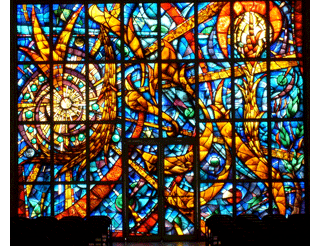In 1850, the B’nai El
Congregation in St. Louis, MO. purchased land to accommodate a cemetery
for the area’s growing Jewish population. By 1888, two other Reform
congregations, Shaare Emeth Congregation and Temple Israel had joined
the Mt. Sinai Cemetery Association which, that year, re-incorporated
under the name New Mt. Sinai Cemetery Association. To this day, the
members of the Board of Directors of the cemetery, New Mt. Sinai, come
from the ranks of the founding congregations, although the cemetery is
an autonomous entity.
New Mt. Sinai holds the remains of over 11,000 people,
and with 52 acres, of which only 35 have been developed, it is
estimated that the cemetery has enough grave space for the next three
centuries. Since the Jewish population has moved to other parts of the
city over the years, New Mt. Sinai promotes the beauty and history of
the cemetery and its convenient location.
 The
cemetery follows the traditions of the Reform community. Although only a
Jew by matrilineal or patrilineal descent may purchase a grave site,
anyone, Jewish or non-Jewish, may be buried in the cemetery.
Accommodations are made for the few burials performed by Orthodox and
Conservative rabbis. The
cemetery follows the traditions of the Reform community. Although only a
Jew by matrilineal or patrilineal descent may purchase a grave site,
anyone, Jewish or non-Jewish, may be buried in the cemetery.
Accommodations are made for the few burials performed by Orthodox and
Conservative rabbis.
By the 1880’s, wealthy Jewish families in St. Louis
were building private mausoleums for above ground burials. Thirty-five
such structures, holding the remains of two, three and even four
generations, had been erected in New Mt. Sinai by the mid-twentieth
century. However, by the 1960’s, these mausoleums became prohibitively
expensive and so, to accommodate the growing trend, New Mt. Sinai built
its unique Community Mausoleum in 1969. The original space had room for
over 300 crypts for coffins and 72 niches for cremains. In 1990, to meet
the rising demand, the Mausoleum added 675 additional crypts and 320
niches.
The dominant feature of the mausoleum is the stained
glass "Window of Truth" at the back of the 200-seat Chapel. This
gorgeous work of art was created out of hand made, mouth-blown glass,
and measures approximately 17 feet high and 20 feet across. It is
composed of thirty panels, containing over 3,500 individual pieces of
glass. The window is based on the three Hebrew letters aleph, mem, taph,
which spell the Hebrew word emeth, meaning truth.
In this beautiful space, funeral services and memorial
services are held. On the Sunday between Rosh Hashanah and Yom Kippur, a
commemorative service honors all those who were buried during the
previous year. On the weekend before Memorial Day, Boy Scouts, Cub
Scouts and war veterans gather to honor the 800 war veterans buried at
New Mt. Sinai, dating from the Mexican-American War of the 1840’s to the
conflict in Afghanistan.
As one of the oldest existing Jewish cemeteries west of
the Mississippi River, New Mt. Sinai Cemetery is a popular place to
visit. Visitors can walk or drive to the Community Mausoleum, the
Veterans Memorial Garden and Monument, the original Chapel (1905), the
House of Comfort (1916), and the burial sites of some of the
historically significant members of the St. Louis community.
For more information about New Mt. Sinai Cemetery, see their website, www.NMScemetery.org.
|







